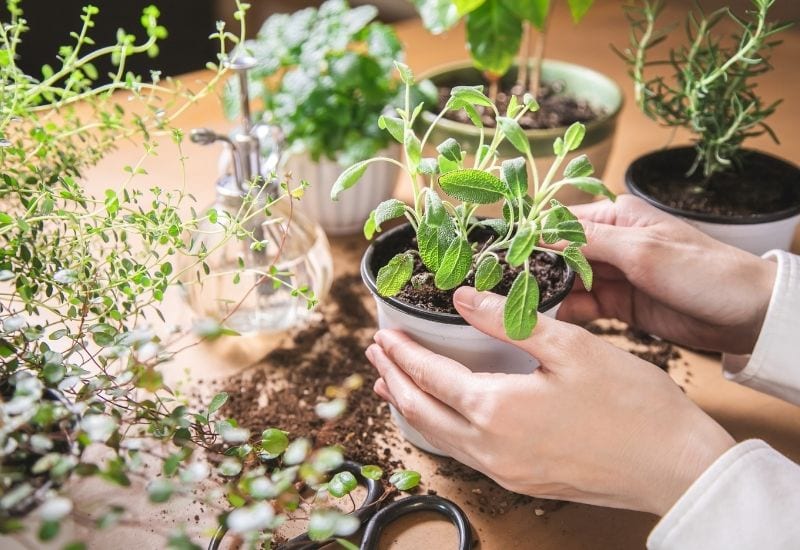
Starting your own container herb garden can be a fun gardening challenge, but it can also turn into a stressful project if managed incorrectly.
As a beginner in the world of growing herbs in containers there are certain common mistakes you should take care to avoid so that your garden can be a success.
Even experienced gardeners will make these mistakes, so educate yourself early on to prevent disappointment!
In this guide I will go through most common mistakes gardeners make when it comes to growing herbs in pot, and how to fix them or how to avoid them completely.
12 Mistakes You Must Avoid When Growing Herbs In Pots
Herbs grown in containers are much more vulnerable to certain issues than those in the ground, so there are few things to Keep in mind before rushing out and planting.
Here are 12 common container herb gardening mistakes to avoid if you want to help your potted herbs thrives all summer.
1. Picking the wrong container
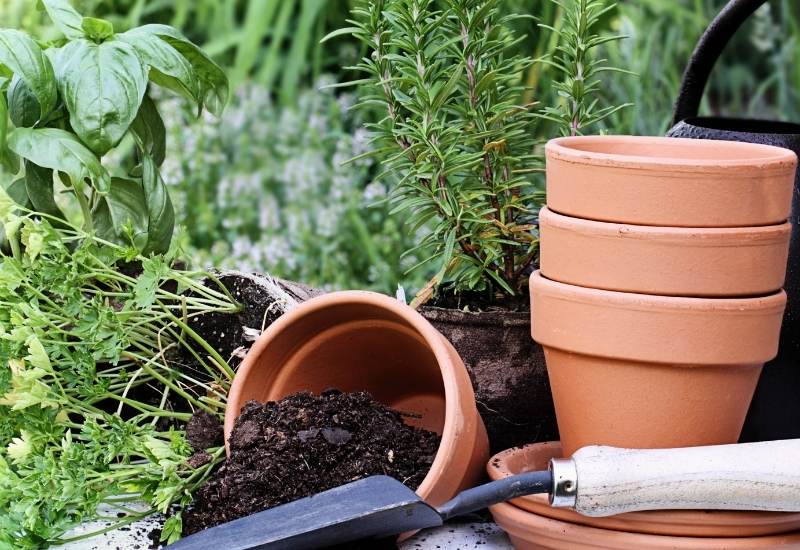
Pick the right size and material container for the needs of your plant, as the pot that you plant your herbs in has a huge influence over the success of the plants.
If you choose a container or pot that is too shallow for the type of herb you are growing, the roots won’t have enough space to grow and develop.
Similarly, you want to ensure that your pot has a wide enough diameter to fit all the herbs you plan on planting inside it.
The material your pot is made from is also an important consideration, as clay or terracotta pots are particularly porous and prone to drying out quickly.
If growing a herb that needs lots of water, like mint, porous containers will leach away the moisture in the soil much too quickly and you would be better off with recycled plastic.
2. Using poor quality soil
Soil is where your herbs get all the things they need to grow and produce fragrant leaves and healthy new growth, so you need to make sure it’s the best quality you can afford.
Skimping on costs and purchasing poor quality soil from the dollar store won’t help your plants do well, especially since many herbs have specific nutritional requirements and growing them in containers means you need to have everything they need in that soil since they can’t get it elsewhere.
You also shouldn’t just fill your pot with soil from your backyard, it will dry out too quickly. Instead, build your own soil or buy a good quality potting soil from a garden center.
Potting soil should have excellent drainage with components like coco coir, peat moss, perlite or pumice, and it should have organic matter like compost mixed in to provide rich nutrition.
You should also make sure it is sterile, which it should state on the bag, to prevent bringing pest eggs or disease pathogens into your pots.
3. Placing containers in a shady spot
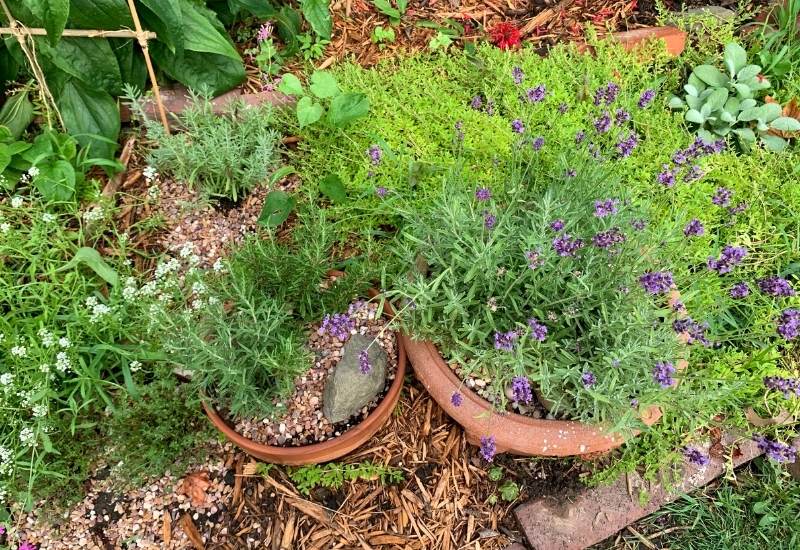
Although there are some shade tolerant herbs, most common container grown herbs like oregano, thyme, sage, lavender, basil and more love the heat and need full sun.
Many beginner gardeners will underestimate these needs and place their potted herbs on a shaded windowsill or on a north facing patio. Big mistake! You will find that sun-loving herbs will begin to wilt, yellow, drop leaves, and lose color when they don’t receive adequate sunlight and heat.
Luckily, if you identify this is the issue quickly you can just move your pots into a sunnier spot- as long as you have one! If you have absolutely no spaces that receive at least 5 hours of sun per day, consider purchasing some growing lamps for your container garden, or growing more shade tolerant herbs like mint or dill.
4. Growing incompatible herbs together
Look up the light, temperature, and water requirements of the herbs you want to grow and make sure to plant like with like.
It’s not a good idea to plant drought tolerant rosemary with moisture loving mint in the same pot, as each will suffer from the watering schedule of the other. The same applies for other care factors and you need to do some solid research before grouping herbs together.
Additionally, just like many fruits and vegetables, herbs have companion plants that they grow well next to and they also have ‘enemies’ that they will not enjoy sharing a pot with. For example, herbs in the mint family typically do not grow well when planted together with chamomile or parsley.
5. Watering too little or too much
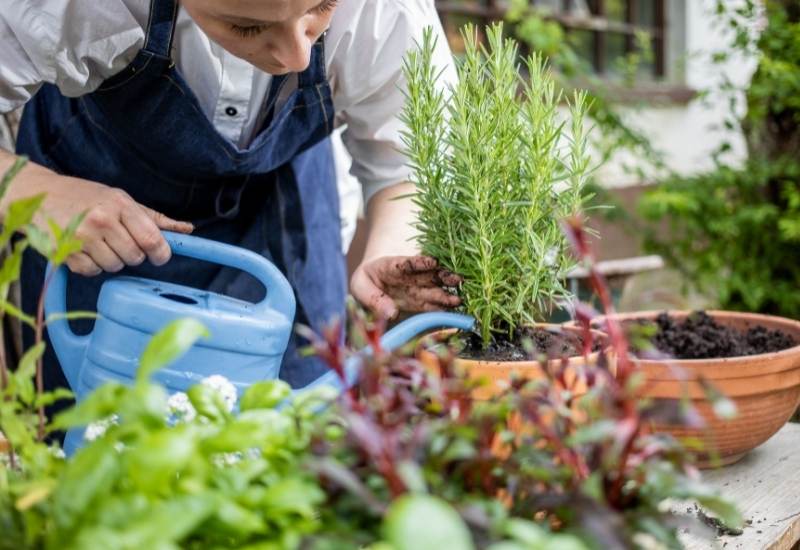
Providing your plants with the right amount of water is a problem for all gardeners, but it is especially difficult when it comes to container herbs which need a little extra water but not too much!
It’s a common issue that many beginner herb gardeners will face when growing in pots, so don’t beat yourself up about it. Since pots are above ground level, the sun heats up the entire container and all the soil inside dries out quickly.
You need to compensate for this water loss, but at the same time many herbs prefer dry conditions so make sure you don’t create a constantly moist or soggy environment for drought tolerant herbs like rosemary, thyme, sage, or oregano.
Instead, give them a deep drink only when the soil is completely dry. On the flip side some herbs -like those in the mint family – prefer slightly moist soil, and you will need to make sure to water them more than you would when growing in the ground.
The best way to find the right balance is to check every few days with your finger the moisture in the soil.
6. Letting the herbs go to seed
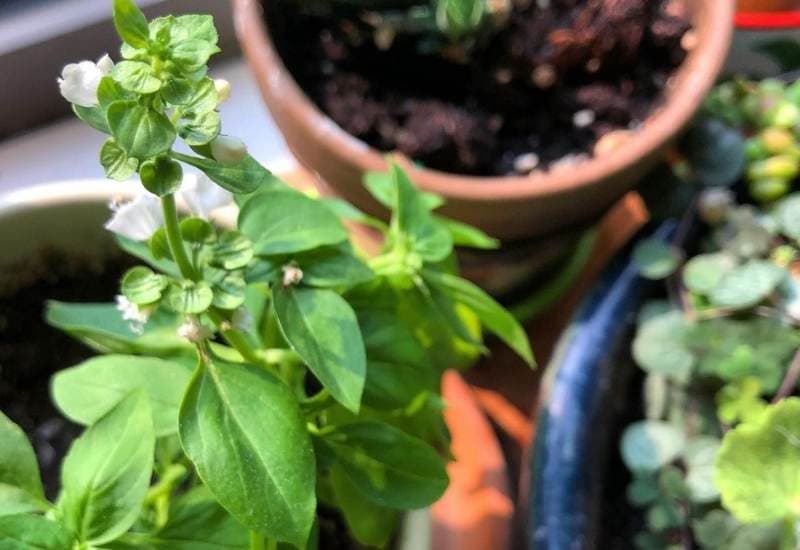
The majority of common garden herbs are harvested for their fragrant leaves and stems, and although many of them have edible flowers and seeds, once you let them focus their energy on flower and seed production the flavor of the leaves diminishes drastically.
To keep usable herbs around for the longest amount of time, care should be taken to prevent them from ‘bolting’, which is the process where plants start to focus on flower and seed production.
When herbs are under stress (often too high temperatures or too low temperatures), they are more likely to bolt because they want to quickly reproduce before they die.
Take care to keep your plant healthy and happy to prevent premature bolting, and when you do see flowers form, cut the heads off to redirect the energy to the leaves. This sometimes has to be done very often to keep the harvest going, especially with herbs like basil or cilantro.
7. Placing containers in a windy spot
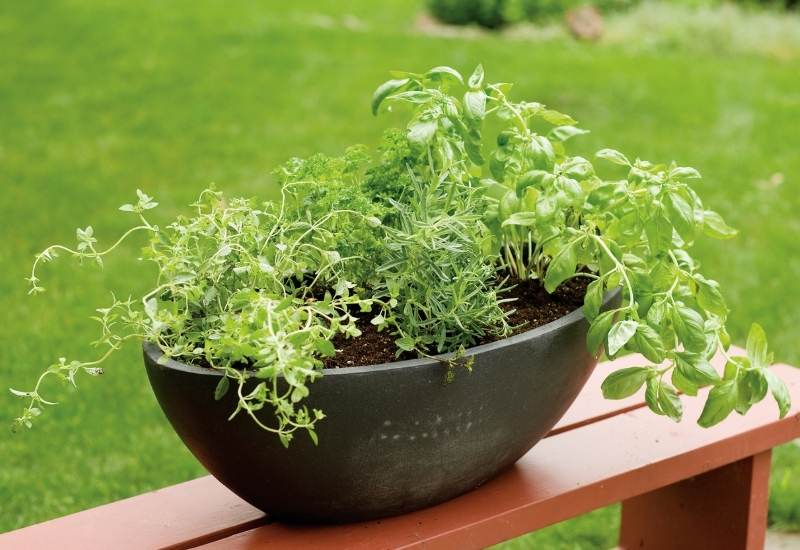
Wind battered herbs will wilt, yellow, bolt, or die before you even get to experience the benefits of growing them.
You already know that you need to take the sunniness of your spot into account, but what about wind? If your herbs are, for example, in a window box hanging off a balcony that gets high speed winds, they won’t be happy! Your containers don’t need to be in a totally wind free environment, but make sure they have some shelter in the form of a low wall or other, taller plants to protect them.
Some herbs are also better suited for windy conditions than others; rosemary’s native environment is rocky cliffs in the Mediterranean, so it’s much better adapted and more resilient to wind than other herbs.
8. Growing the wrong herbs for your climate
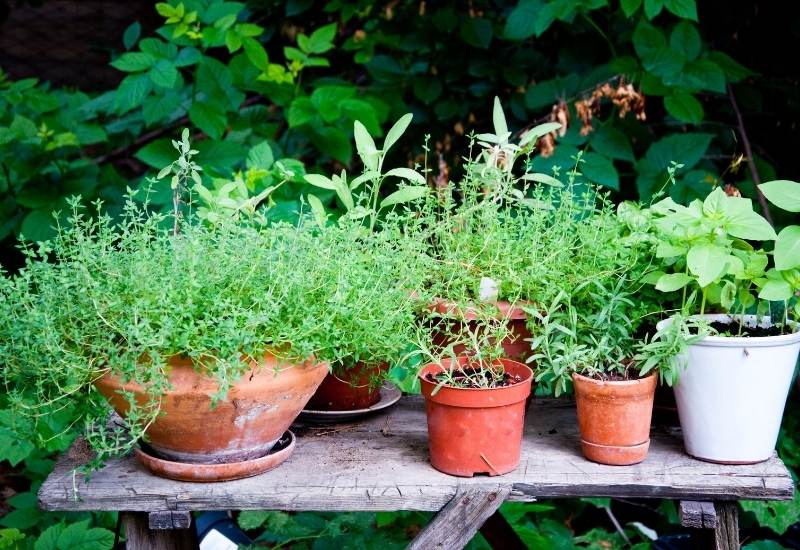
Choose herbs that are well suited or native to yoru area. If you are placing your container herb garden outside in your garden, on your patio or on a balcony, make sure you consider how your local climate will affect them.
There are some obvious unfavorable climates like harsh winters with freezing temperatures and snow that will kill most herbs. But even subtle factors like the amount of constant cloud cover and rain you receive can result in weakened plants that are disappointing to look at and eat.
Select herbs for your garden that are suited to your region, especially when growing them in seasons other than summer. This is also a fun reason to explore native herbs that might even grow wild in your area that you haven’t heard of before!
9. Overcrowding herbs
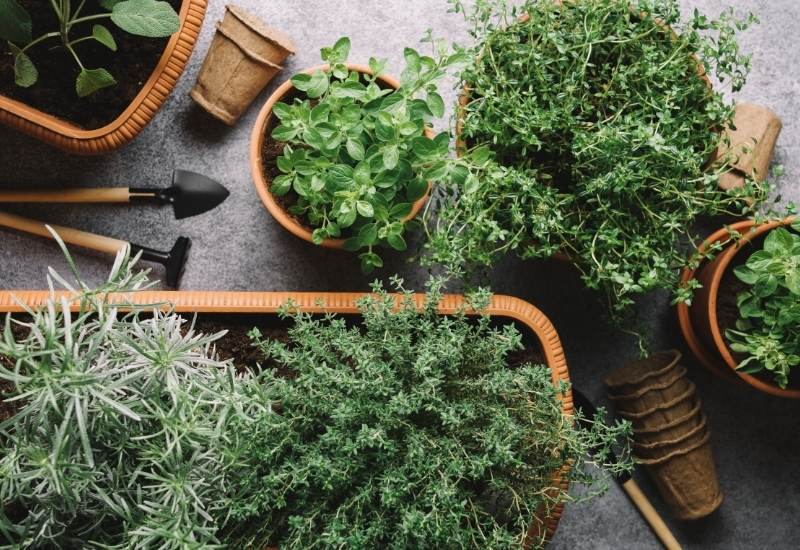
Be careful not to plant your herbs too densely and take into account that they will grow and expand a lot!
Many herb gardeners will grow many herbs together in one pot or window box, and many of them do grow well together and deter insects with their powerful scents.
When planting seeds or transplants it’s easy to underestimate how large your herbs will become, especially since many of them will grow to fit the space they are given.
Cramming too many herbs into one pot will result in competition for resources, lack of airflow, and increased risk of diseases amongst your plants.
Overcrowding also makes it difficult to water at the soil level and you will likely end up with very wet leaves, further contributing to fungal disease risks. Don’t be too greedy with how many herbs you can fit in one pot, because you might end up losing them all!
10. Buying sick or diseased herb transplants
Do research before buying young herbs and look for labels that have certifications that state plants have come from a sterile environment.
A number of herbs are hard to get established from seed, often woody herbs like rosemary, sage, and lavender, and it can take many years before they are mature enough to actually produce a harvest.
As a result, most gardeners will purchase these herbs as transplants from nurseries, neighbours, or plant centers, so that they can be used that season or the following year.
Always buy from reputable sellers that are trustworthy, or you could end up with diseased herbs that rapidly spread disease pathogens around your container garden and cause all your herbs to suffer as a result.
11. Spraying herbs with synthetic chemicals
Since most herbs are eaten raw, spraying them with synthetic, glyphosate based pesticides and fertilizers can be dangerous for you to ingest and harmful for your garden.
Herbs that are grown in containers usually have much more controlled conditions and raised up above the ground often means fewer pests.
Try weeding by hand, using natural pest control measures like neem oil, and fertilizing with compost tea or composted manure to give your plants a boost instead of resorting to chemical intervention.
If you really feel that you need to use something stronger on your herb garden, make sure it has a “safe for edibles” label on it.
12. Not fertilizing your garden enough
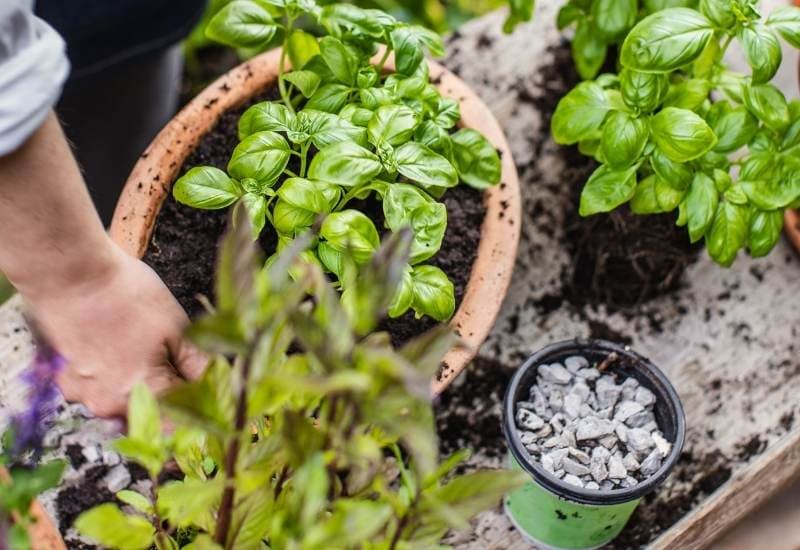
Potted herbs have less access to other sources of nutrients than those grown in the ground, and they need to be fed with a natural fertilizer every month or so.
Many gardeners who have perennial gardens can appreciate the hardiness and resilience of certain herbs, especially the drought tolerant ones that can succeed in poor soils, and as a result will forget to feed their container grown herbs.
Even the tough ones need a meal now and then! A great option is homemade compost, blood and bone meal, compost tea, or composted manure, which all have most nutrient groups covered and will give your herb garden the boost it needs.
Learn from Your Mistakes!
If you keep these twelve common mistakes in mind, you should see a lot of success in your container herb garden.
But there are always things that can go wrong from one season to the next, so keep a positive attitude and learn from your mistakes.
Make sure you are observing all the regular care requirements for your herbs as stated on the seed packets or labels, as generally healthy plants are more resilient to other issues.
Pick the right pot, spot, seller, and herbs, and you should be reaping the benefits of growing and using fresh, fragrant herbs for years to come.

Written By
Amber Noyes
Amber Noyes was born and raised in a suburban California town, San Mateo. She holds a master’s degree in horticulture from the University of California as well as a BS in Biology from the University of San Francisco. With experience working on an organic farm, water conservation research, farmers’ markets, and plant nursery, she understands what makes plants thrive and how we can better understand the connection between microclimate and plant health. When she’s not on the land, Amber loves informing people of new ideas/things related to gardening, especially organic gardening, houseplants, and growing plants in a small space.
